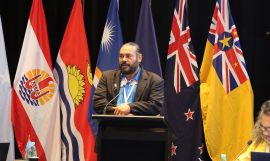The Pacific region is extremely vulnerable to natural disasters.
Each year, the region faces economic losses amounting to USD$500 million. With climate change likely to continue, the magnitude of these disasters will only increase.
Therein lies the need for a long-term solution to weather-related extreme events and multi-hazard early warning systems (MHEWS), a message delivered by the Director of Tonga’s National Meteorological and Hydrological Services (NMHS) and President of the World Meteorological Organisation Regional Association V (WMO RA V), ‘Ofa Fa’anunu, during the Pacific Disaster Risk Management Ministers Meeting held in Denarau, Fiji.
Hosted by the Fijian government, the meeting is the first ministerial meeting for Disaster Risk Management in the region, and is organised by the Pacific Community (SPC) in partnership with the Pacific Islands Forum Secretariat (PIFS).
Fa’anunu presented on the Weather Ready Pacific Decadal Programme of Investment, an initiative developed by the Pacific Meteorological Council (PMC), with the support the Secretariat of the Pacific Regional Environment Programme (SPREP), WMO, and the Government of Australia through the Australian Bureau of Meteorology. It was officially endorsed by the Pacific Islands Forum Leaders Meeting in 2021.
“Right now, the Pacific does not have a project that deals with severe weather. A lot of investment goes to research into long term climate change, but there is no investment in dealing with events such as cyclones, extreme weather and tsunamis that are happening right now,” he said.
“We are looking for long-term solutions, no more of these two or three year-projects.”
The Weather Ready Pacific Programme will be just that – a ten year programme of investment that will strengthen the region’s ability to anticipate, plan for, and respond to high impact and extreme weather, water, and ocean events.
The programme aims to protect communities by ensuring that forecasts and warnings is more specific and clearer about local conditions and potential impacts. It aims to support economies by ensuring that forecasts and warnings provide timely and targeted preparedness measures, limiting the impacts of severe weather events.
The Weather Ready programme will also strengthen security by providing better access to reliable weather information which will support the region’s maritime surveillance ad enable better preparedness for events that could lead to political or social destabilisation; and enhance connectivity by strengthening the region’s integration into the global meteorological system so that it is less vulnerable to the peaks and troughs in resourcing and support.
Weather Ready Pacific has five areas of investment, one of which is Governance, Coordination and Leadership. This refers to legislation and regulations specific to Multi-Hazard Early Warning Systems (MHEWS).
“Currently, only one country in the Pacific has a Multi Hazard Early Warning System Policy, and that is Samoa. This is important for countries to consider putting together proper guiding country-driven principles on MHEWS.”
Another area of investment under the Weather Ready Pacific Programme is Communication of Forecast and Warnings. According to Fa’anunu, you can have the best forecast, but if it is not disseminated or communicated, it is of no use to anyone.
“Warnings should be accessible to all and free of charge. No one should not be able to receive a warning because they don’t have access to the medium through which the warning is being transmitted,” Fa’anunu said.
“Access to warnings is a basic human right, as stated by the Crown Prince of Tonga during the first Pacific Ministers of Meteorology Meeting in Tonga in 2015,” he added.
The other areas of investment include Forecast and Warning Production, Infrastructure and Observations, Capacity and Training.
Fa’anunu revealed that the Programme has a goal of USD 166 million for ten years. But while the amount might be daunting at first glance, it is only 3% of the total annual losses the Pacific faces as a result of natural disasters.
He concluded with a request to the Ministers to support the immediate financing of the Weather Ready Pacific Initiative.
SOURCE: SPREP/PACNEWS














